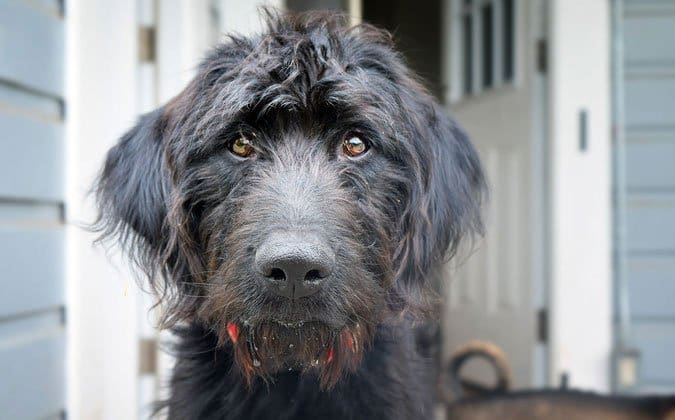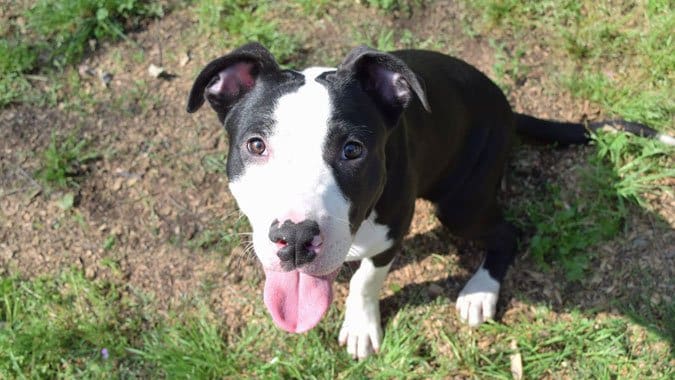Here’s another post to provide closure to some of the foster-dog stories I’ve shared with you in recent months.
In mid-March, I wrote about being fairly depressed by the arrival of two foster dogs. I had pulled the first one from my local shelter as a prospect for a friend of my son, who was looking for an athletic, medium-sized dog. I had never seen the dog outside of a kennel, first at my local shelter, and then, after we evacuated the shelter during the Oroville (Calif.) Dam scare, at a friend’s house (she took in about 20 of the shelter’s dogs!). He had a darling face, seemed quiet in the kennel, and looked like a Poodle-something-mix. As soon as it was safe for me to go back home after the evacuation, I asked to foster him.

It wasn’t until I got him home that I saw he wasn’t going to work for my son’s friend. That young man is a professional athlete, and was looking for a dog he could take out for runs; this dog could barely stand up! He had as little muscle tissue as I’ve ever seen on a dog, and he stood and walked way back on his “wrists.” It seemed clear he had been kept in a crate or tiny pen for most of his life. He also had a bad habit of barking LOUDLY when he wanted something or when he was frustrated. This, too, seemed like a trait he had likely developed while being stuck in a crate. He didn’t have any other tools for dealing with his frustration.
Despite this bad start, he was friendly and sweet and playful. I called him Muppet, because he looked like one, with those long legs and tufts of hair flying every which way. Based on his uncoordinated, weak gaits, my husband, who gives nicknames to every dog that passes through our home, called him Floppy. Indeed, he flopped about wildly as he tried to play with and chase my adolescent dog Woody around my yard. It was sad but funny when they would play tug of war over a toy; they would stand braced and pulling, and it would look like an even match, but if strongly muscled Woody would turn his head to look out the window, Floppy would go flying in that direction. It only looked like it was an even match because Woody was tempering the strength of his own tugging.
Still, it takes a special person to make a home for dogs with physical and behavioral deficits, and I despaired that I would be able to find a suitable family for him. Then I received a message from Jill Breitner, developer of the terrific Dog Decoder app and a trainer who recently relocated in southern Oregon. She said that she had a couple of clients that Muppet might be perfect for, and that in either case, she would first take possession of him for a month or so, and then spend some time with the owner, to make sure they knew what to expect from the dog and to smooth over their new relationship.
As it turned out, another friend was driving a couple of dogs from our local shelter to central Oregon, where she would meet another driver who would take them to adoptive homes in the Seattle area. I asked if Muppet could catch a ride on that transport, and a few days later, he was on his way.
As luck would have it, the person doing the transport had car trouble on the morning that all the travel arrangements were made, and instead of being crated individually in the back of a truck with a camper shell on it, the dogs were going to ride in a car – the back seat and the “way back.” And as they drove, one of the dogs being transported was quite unhappy with the seating arrangements, and made the other dogs in the car nervous enough that by the time Muppet got to Jill’s town, he had diarrhea and no appetite. It took a couple of days of gentle care and low-stress, loving handling before he regained his adolescent energy and spunk.
I’ve asked Jill if she would write an article for WDJ about her approach to this sort of fostering/training arrangement, and she’s agreed. Briefly, she said she tries to give the dog a soft landing from his previous placements, and give him time to feel safe and loved in the most enriching environment possible. She observes the dog carefully to see how he moves and operates, and so she can share her insights about his behavior with his new owner when it’s time. Jill kept Muppet for over a month before his new owners drove up from Arizona to get him! They spent two days with Jill and Muppet getting to know their new dog and his newly trained behaviors, before driving with him back down to Arizona. Jill says they are in love with their new guy, who has been permanently renamed Buffett (after the musician). Super happy ending!
Despite the frustration I expressed when I wrote that first blog post about hard-to-place dogs, the other dog I was writing about also has found a terrific forever home. Twig is an anxious little guy with funky-looking knees, who had scrapped with his previous foster person’s dog and needed a new home before he got hurt. I asked Lisa, a friend who is involved with a local rescue group, if she could foster him for me when I went on vacation, and when I got back, she said she could keep him a little longer, trying to promote him through her network of rescue folks.

Lisa has cultivated a relationship with the local television station, who will sometimes feature an “adoptable pet of the week” on its morning show – and make the clip available for linking and sharing on social media. Lisa got onto the show with Twig, and lo and behold, the perfect couple emerged within a day asking to meet and adopt him. They are an older couple with no other dogs, and he reminded them in many ways of a beloved dog they had years ago. They took him home for a trial and say he fits into their lives perfectly. Hurrah! Networking (literally) rocks!
More recently, I complained about these adorable siblings, who have been in my local shelter since just before Christmas. I shared my theory that they looked too much like pit bulls to attract people who did not feel comfortable with a bully breed, and not enough like pit bulls for those who specifically wanted a bully breed.

It so happened that I was at the shelter one day for an unrelated task (actually, helping Lisa, hero of Twig’s story, check to see if the next dog she was about to foster had any issues with cats), when I saw someone else I know at the shelter, taking a shelter ward to one of the outdoor runs. I wandered over to see what she and her husband were up to, and they said they had lost two senior dogs, one after the other, earlier this year, and their remaining dog is depressed and sad, and so they decided it was time to adopt another; they were just looking. I went into total car salesman mode. “Have I got a dog for you!” I told them, and ran to get a leash. I ran back to the boy dog’s kennel, telling him, “Now don’t blow this, it’s a great opportunity for you…” I showed them everything the dog knew: sit and down on cue, polite fetching, and best yet, a default sit and wait when you just look at him, or when you walk up to a door or gate. Long story short: He got adopted!
Now I’m concentrating all my efforts on his sister. I brought her home over the weekend, and this week, she’s spending time as a special guest at The Canine Connection, my friend Sarah Richardson’s training, boarding, and daycare center. Sarah’s assistants are lavishing care and training on her, and she’s getting lots of opportunities to play with other dogs. After I send the next issue to print, I hope to host her again while promoting her as widely as I can, in any way I can. And then, I might have to take the rest of the summer off to play with my own dogs only!

In the comments to the above-mentioned blog posts, you guys have contributed some great ideas for helping shelter dogs get adopted. Keep sharing! And thanks!






